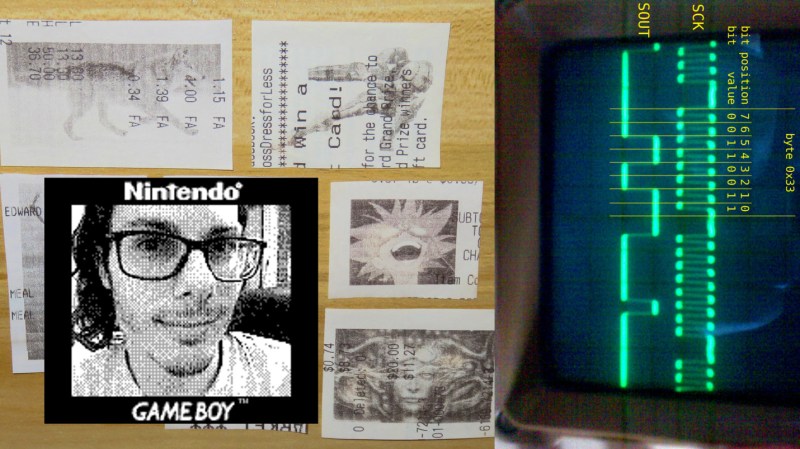[Dhole], like the fox, isn’t the first to connect his computer to a Game Boy printer but he has done a remarkable job of documenting the process so well that anyone can follow. The operation is described well enough that it isn’t necessary to scrutinize his code, so don’t be put off if C and Rust are not your first choices. The whole thing is written like a story in three chapters.
The first chapter is about hacking a link cable between two Game Boys. First, he explains the necessity and process of setting the speed of his microcontroller, a NUCLEO-F411RE development board by STMicroelectronics. Once the rate is set, he builds a sniffer by observing the traffic on the cable and listens in on two Game Boys playing Tetris in competition mode. We can’t help but think that some 8-bit cheating would be possible if Tetris thought your opponent instantly had a screen overflowing with tetrominoes. Spying on a couple of Game Boys meant that no undue stress was put on the printer.
Chapter two built on the first chapter by using the protocol to understand how the printer expects to be spoken to. There is plenty of documentation about this already, and it is thoughtfully referenced. It becomes possible to convince a Game Boy that the connected microcontroller is a printer so it will oblige by sending an image. Since there isn’t a reason to wait for printing hardware, the transfer is nearly instantaneous. In the image above, you can see a picture of [Dhole] taken by a Game Boy camera.
The final chapter, now that all the protocols are understood, is also the climax where the computer and microcontroller convince the printer they are a Game Boy that wants to print an image. In the finale, we get another lesson about measuring controller frequency without an oscilloscope. If you are looking for the hack, there it is. There is a handful of success in the form of old receipts with superimposed grayscale images since virgin thermal printer paper by Nintendo costs as much as a used printer.
This story had a happy ending but grab your reading glasses for the smallest Game Boy and here’s someone who wrote their own Game Boy color game.
















I wonder why people still mess around with the worst camera and printer ever.
Thermal printers can be found for <$5 on Ebay, even older ones with a serial port, if you want to connect it to a microcontroller. The protocols are well known for many models, and even Linux supports them officially.
Oh, and the paper is standard format, so you can get the rolls a dime a dozen.
because they can, feel nostalgic about it, because they want to find out if they can… and it’s fun to try. Hope that helps.
Could you link those <5$ printers? Because I sure as heck haven't found them at that price point.
As it goes with ebay, sometimes there are none, while sometimes you can get 10 for a dollar each.
Here’s a really cheap one, although without electronics, but according to the comments here, that’s an even stronger argument to use it.
https://translate.google.com/translate?sl=de&tl=en&js=y&prev=_t&hl=de&ie=UTF-8&u=https%3A%2F%2Fwww.pollin.de%2Fp%2Fthermo-druckelement-matsushita-epl1801s2e-721066&edit-text=&act=url
Thank you!
Why make a Gameboy in an FPGA when you can use an emulator? Because it is fucking rad
Rad sure gets a lot of action.
If you ask “Why?” this blog is not for you.
Translated into Italian, it also rhymes.
What else would you expect on Hackaday? If there was no hack…
why does anyone do anything
Because you learn a lot of practical stuff doing that sort of thing…